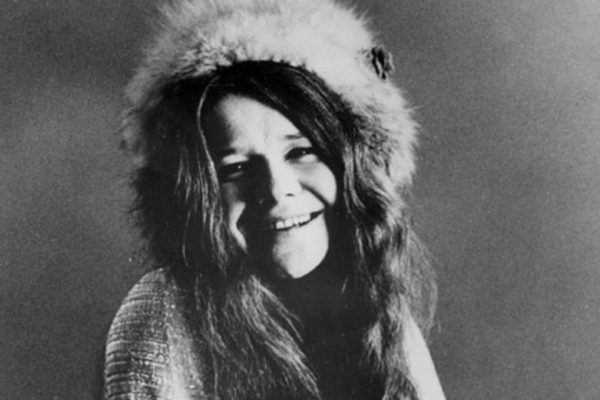A good biography situates the subject in a historical context, weaving together two timelines and examining their points of intersection. Holly George-Warren’s book Janis: Her Life and Music does just that, showing how a bookish, insecure tomboy from Port Arthur, Texas found her voice and quickly sang her way to stardom at the epicenter of the cultural revolution of the 1960s.
Related: “Even Janis on an off-night was incredible…”
I went from age eleven to age fourteen over the course of Janis’ career—too young to appreciate her as an artist or performer. Somewhere in my brain, I was figuring out how to be a woman in this culture, and Janis’ transgressiveness probably scared me. The raw emotion of her vocal and the picture she painted of love and romance was probably too dark for my young ears, and I didn’t want to see a woman in so much pain.
As I got older and began looking at sixties music through a feminist lens I revisited Janis and found her fascinating. George-Warren’s book is a great opportunity to revisit Janis yet again and gain a deeper understanding of how this utter original came into being, and why it was so hard for her to be. I was inspired to follow Janis’s discography as I read.
The booming oil industry in Port Arthur provided the Joplin family with a comfortable middle-class lifestyle, including two doting parents who created an artistically and intellectually enriched environment for their precocious, energetic daughter. Her free-thinking, broody father encouraged her to see the world critically, and early on explained what he called the Saturday Night Swindle—expect disappointment, happiness doesn’t last; “life sucks,” in today’s vernacular.
Her mother had a sunnier disposition. She encouraged Janis to be strong and independent while at the same time hoped her daughter would conform to what Janis saw as the stifling Eisenhower-era pretenses of everyday life. And she must not ruin her reputation! Some of the messages she got from her parents, especially her father, were very progressive for the time and place, making Janis different from friends and classmates in fundamental ways. She was often the object of their cruel humor, and her few close friends sometimes joined in the abuse.
Though Janis sang in choirs as a child and young teen, her life changed in high school when she, literally and metaphorically, found her voice. She knew she could sing. The other transformative event of her high school years was reading Jack Kerouac’s On The Road.
She styled herself a beatnik, but it was more than just leotards, men’s white shirts, and dungarees. She became a voracious reader, a serious student of blues, and a visual artist. All her artistic endeavors provided opportunities for self-expression, but it was through singing that she could best express her pain and discomfort with the world. And she developed a deep appreciation for alcohol.
After escaping conservative Port Arthur for the University of Texas at Austin, Janis became part of the local folk music community. Kenneth Threadgill, country singer and bar owner, took her under his wing and gave her opportunities to perform and grow. Janis found herself the object of cruel humor in Austin, too. Somehow she found the inner resources and determination to be herself as she figured out who she was. At this point, she was a sexually adventurous beatnik with a tough blues mama rising. And she was too much for the small-minded Austin college crowd.
Chet Helms, a figure on the Austin music scene, heard her sing the blues and convinced her she could make it as a singer in San Francisco; off they went to North Beach, the beatnik enclave.
In May of ’65 Janis was back in Port Arthur, weighing 85 pounds and addicted to speed. Struggling to figure out who she was and how to live, she went back to Lamar Tech in Beaumont, where she had taken some classes before going to Austin. The straight life beckoned, but so did the life of the beatnik artist and blues singer.
She and Helms traveled back to San Francisco the following year, this time to Haight Ashbury, ground zero of the emerging counterculture. Janis told Helms, “I don’t feel like I’m lying now.” She felt she had found her tribe, finally. Janis started singing with Big Brother and the Holding Company, with Helms as manager. Her performance at the Monterey Pop Festival projected her into the stratosphere. Three years after that glorious moment she was dead.
Janis loved writing letters. With childlike excitement, she kept her family up to date on all her career happenings. She expressed joy over her success and immense satisfaction about achieving the recognition she so craved. Selectively, she told them about friends and lovers. George-Warren’s well-researched and beautifully written account takes the reader up close to watch as Janis morphs from beatnik to hippie to rock goddess, all the while eschewing convention yet still seeking her parents’ approval.
Related: “With ‘Face It,’ Debbie Harry Looks Back — and Forward”
Janis was working on a new album and in a new, promising, relationship the evening she died. Alone in her hotel room, she skin-popped a small quantity of heroin, not knowing its purity was greater than she was used to.
Three months before her death, Janis went back to Port Arthur to take care of some unfinished business. In silk and feathers, entourage in tow, she triumphantly sashayed into her high school reunion. George-Warren’s Janis shows us a powerful, fragile woman with the sense of humor and sense of self to think that would be a fun thing to do. I think Janis is resting in peace.
-Candy Leonard
Photo: Janis Joplin (public domain)





0 comments on ““Janis: Her Life and Music”: Revisiting A Legend”